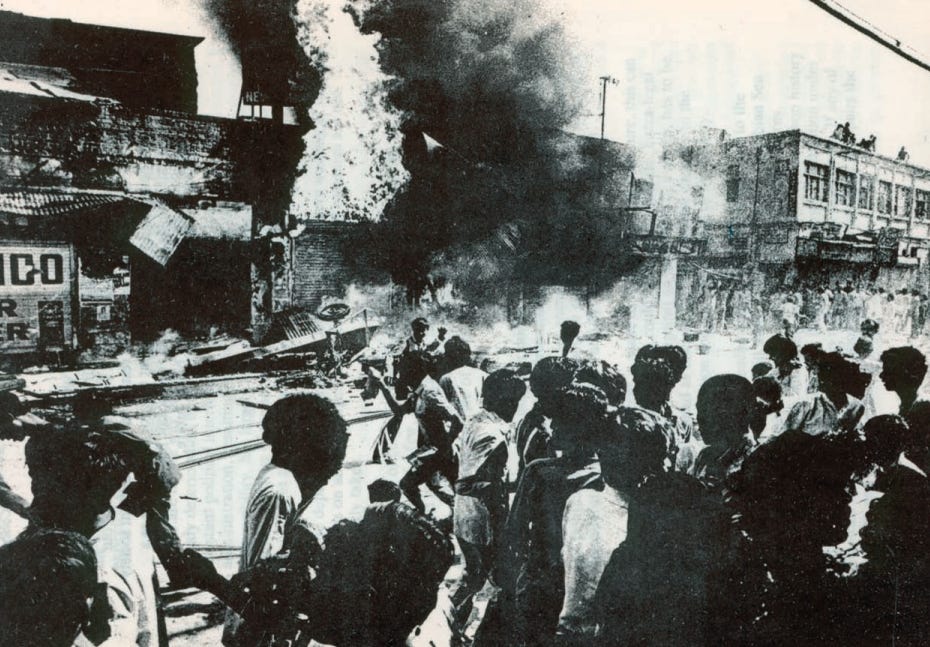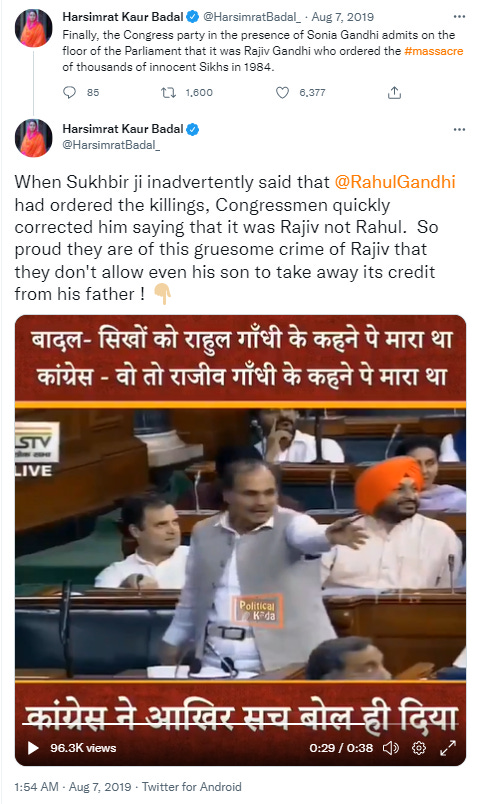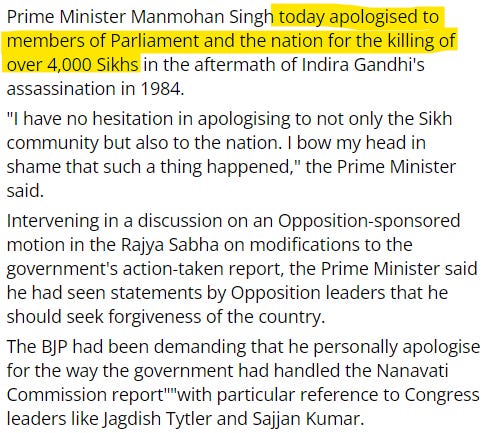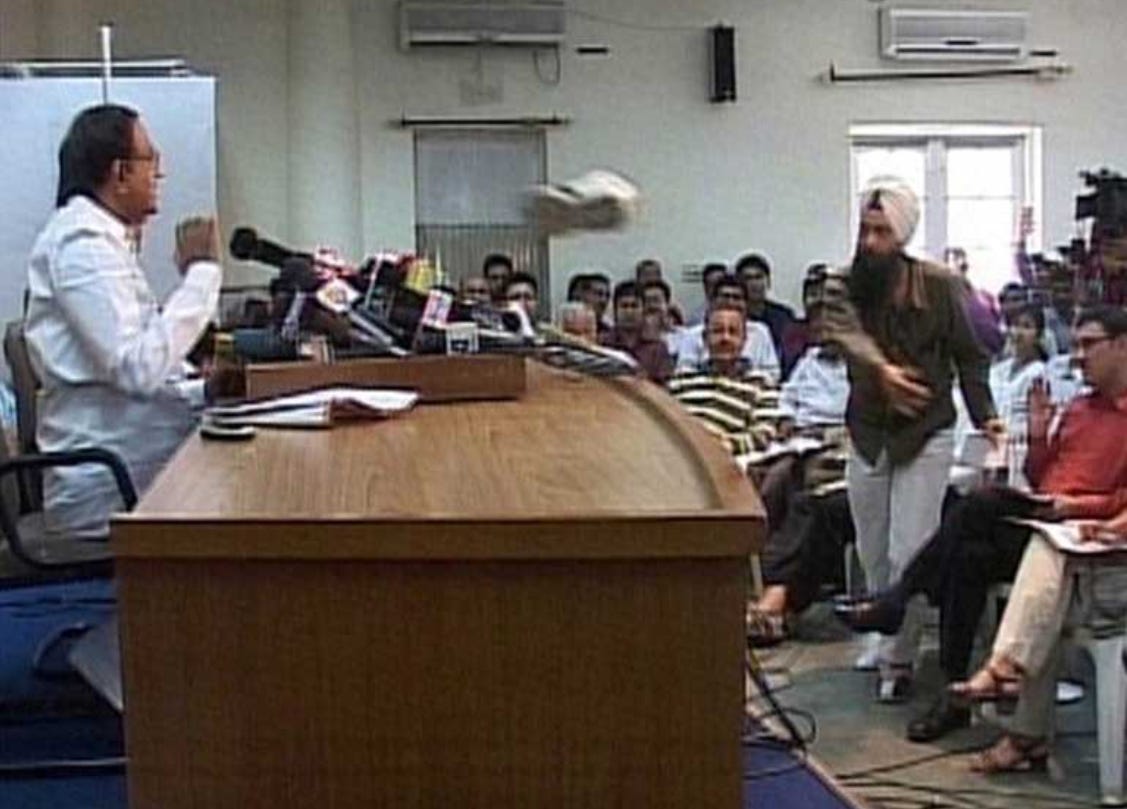Drishtikone Newsletter #334: The 1984 Sikh Massacres
By the afternoon of October 31st, 1984, Congress had unleashed deadly violence against Sikhs after Indira Gandhi's assassination. An in-depth analysis
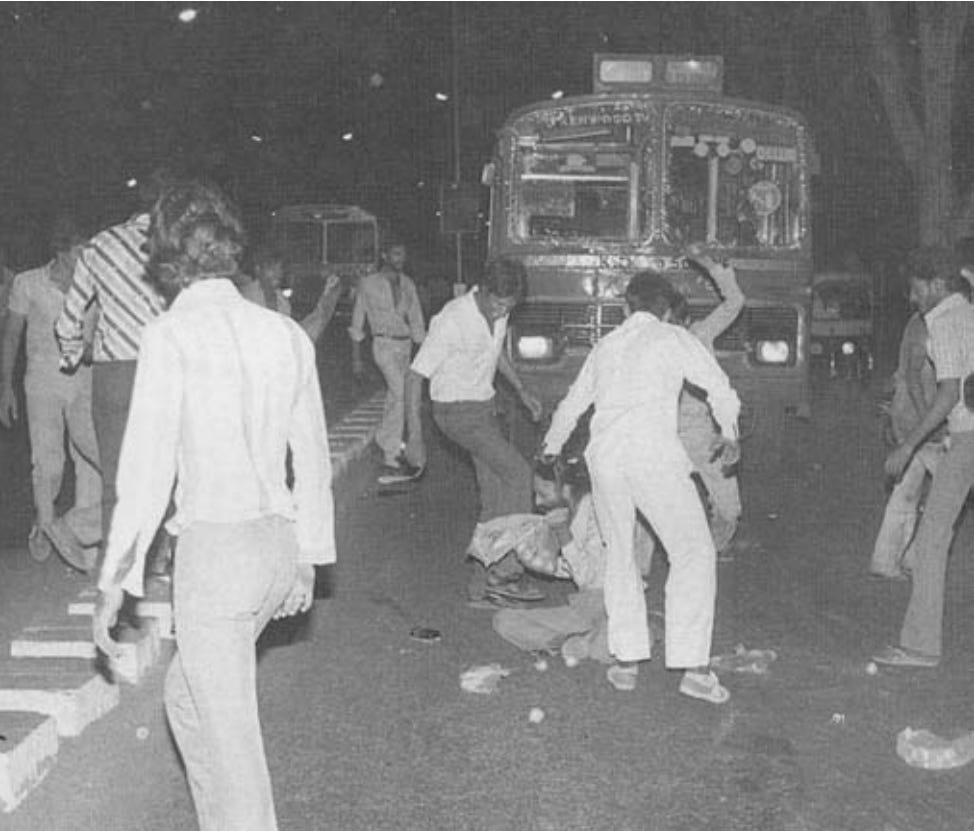
“The truth does not change according to our ability to stomach it.” ― Flannery O'Connor
The sun had been out for a while. Not as hot as Delhi's summer sun can be. Spring had given way to summer. The cusp. It wasn't noon yet. A woman knocked on the door. I could see her across the brick-laced verandah. As I opened it, the eyes which had cried so much that they had forgotten about the tears looked at me. She was asking for help. A beggar? I called my mother.
As my mother came to the door, she realized, that this lady was a Sikh.
It was 1986.
Teary-eyed, she called her in and fed her. Then she took her to the Gurudwara two streets away and put her in touch with the main leaders there so she could get some work and a place to stay at.
Sikhs never beg.
Never will you see a Sikh begging. That is why what happened at our door that morning was so devastating and heartbreaking.
That lady broke something so deeply in my mother's heart that she could not get over her for many months.
On November 1st, 1984 when "all hell broke loose" in Delhi, I had joined the men in our street to guard the entrance of our street so no one could enter. Furniture, valuables, and jewelry of our Sikh neighbors were kept safely in our home.
For my mother, it was a repeat of the partition violence. She would remember how she and her parents had left their village in Sheikhupura district near Lahore with nothing but sandals and clothes on them. How their neighbors who were entrusted with the valuables had turned on them that evening itself.
That could not happen again this time.
After the violence was over, around November 8th, I went out on the Delhi Transport Corporation (DTC) bus to Patel Nagar to first-hand see what had happened. I had seen how mobs had descended on the shops owned by Sikhs and destroyed them.
One was an electronics store. The slum dwellers had come looting and in one funny yet tragic incident, a young guy had picked up a color TV from the store being looted and as he was crossing the road, it fell from his hands and broke. He winced and then went back and got another one.
A young Sikh guy had started a music cassette store. He used to be a local goon but had reformed. After years of hard work, he had gotten something going. It was reduced to trash.
After a month, when I would pass by the local slum, I would see how the small tents where residents would steal electricity from the overhead wires and did not have enough place to sleep would have expensive color TVs inside.
In those days, I got a taste of what my parents and grandparents would have gone through during the partition.
It left such a deep impact in my mind that when in 2005 when I read a news outlet mention those events as "Hindu-Sikh riots" - even when I knew firsthand that it was a massacre of a community by a political party, I realized how the narratives around events that I had personally witnessed had been falsified.
They were not "riots" because no Sikh went about rioting. They were massacres.
If things that I have experienced firsthand could be distorted, I reasoned, imagine what would have happened to our history?
That was the birth of Drishtikone. A chronicle of my times, in my words for my coming generations. At least things that I see will have a history from a viewpoint different from the doctored "official" one.
So the idea of Drishti (view) Kone (angle) or "Perspective" took shape.
The Delhi Sikh massacres were the trigger for this entire effort way back in 2005.
So today let us dive deep into what happened in those fateful days after Prime Minister Indira Gandhi's assassination.
The walk and the revenge
At 9.15 AM on October 31st, 1984 shots broke the silence in Lutyen's Delhi. India's Prime Minister Indira Gandhi had been shot at by her bodyguards - Beant Singh and Satwant Singh. Wearing a saffron saree with a black border, she was going for her interview with Peter Ustinov, a British Actor, for Irish TV. constable Narayan Singh, personal security officer Rameshwar Dayal, and personal secretary, R. K. Dhawan accompanied her. She had to meet James Callaghan, the former British Prime Minister that day, and then in the evening host a dinner for the British princess Anne, Queen Elizabeth's daughter.
After a breakfast of toast, orange juice, eggs, and cereals, Indira Gandhi was checked by her doctor Dr. KP Mathur just like every morning. Ustinov was waiting at the Prime Minister's office.
At 9.10, she started walking towards the office.
In conversation with RK Dhawan, the Prime Minister stepped into the gates of 1 Akbar Road as Narayan Singh carried a black umbrella.
Suddenly, Beant Singh took out his revolver and shot at her. The first bullet hit her abdomen. He fired two more into her chest.
Beant Singh shouted at Satwant Singh, standing nearby to fire at her as well. Satwant Singh emptied 25 bullets into her.
Rameshwar Dayal was also hit. He fell.
There was silence.
Beant Singh hung his walkie-talkie on the fence and raised his arms and said.
'I have done what I had to do. Now you do what you like.'
He was avenging Operation Bluestar.
The Indo-Tibetan Border Police commandos surrounded Beant and Satwant Singh and took them to the nearby security hut.
It is alleged that they tried to escape when they were shot. Beant Singh died on the spot. Satwant Singh was badly wounded. He was finally hanged in January 1989. (Source: India Today "The Last Walk")
Really?! The guys who, after shooting the Prime Minister, put down their weapons and surrendered would have tried to escape?
Who tried to kill Satwant and Beant Singh and Why should have been the most important questions to answer. But never were!
Dhawan and a police officer, Dinesh Bhatt carried Indira Gandhi to her Ambassador car. Makhanlal Fotedar, her political secretary, was also there. Soon Sonia Gandhi came running shouting "Mummy, Mummy" and they all rushed her to the All India Institute of Medical Sciences (AIIMS).
They reached at 9.32 AM.
Doctors struggled for around 5 hours. 80 bottles of blood were given to her.
At 2.23 PM they declared her dead.
BBC broke the news first. (Source - India Today "The last day of Indira Gandhi")
Teaching a lesson
Rajiv Gandhi returned to Delhi and at the airport, he asked those present to meet him on what was being done and then spoke his mind.

During the National Executive meeting of the Bharatiya Janata Party, reports from various states regarding the attacks on the Sikhs were being reviewed. It was learned that Shyam Khosla, a senior journalist, and Krishan Lala Maini (ex-Finance Minister of Punjab) had talked to some senior government and military officials.
Rajiv Gandhi's directive was clear.

Who did he want to teach a lesson to?
The Sikhs. All Sikhs!
The die was cast.
Blood for blood - The Congress Way
As Doordarshan was telecasting Indira Gandhi's 'lying in state', Rajiv Gandhi was standing beside her in a white kurta pajama. Congress leaders and their supporters were busy shouting slogans like "Khoon ka badla Khoon".
Sadly it wasn't just the Congress leaders but as per some witnesses, even the Bollywood superstar Amitabh Bachchan was seen shouting these hate slogans.
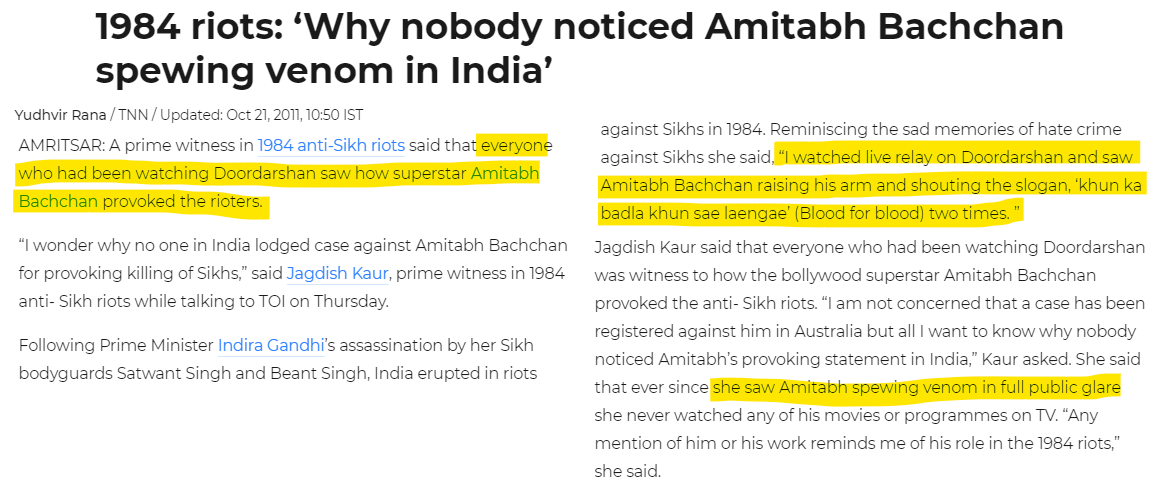
These public statements, the hate speech, and sloganeering during publicly televised full-time news on India's official government channel became a dog whistle. A trigger to set forth hundreds of mobs to hunt the Sikhs.
When Rajiv Gandhi came out to make a statement and justified the entire violence one knew that his administration had the back of the rampaging mobs and would work overtime to save the guilty. They did not disappoint them.
Senior Advocate HS Phoolka also said that the instructions to kill during the anti-Sikh attacks came directly from the Prime Minister's Office.
Interestingly, in a Freudian flip, Congress agreed to it in the Parliament as well.
Here is the video as well.
0:00
When the situation demanded action and the President and the Home Minister were asking for the presence of the Army, someone vetoed them. Who?
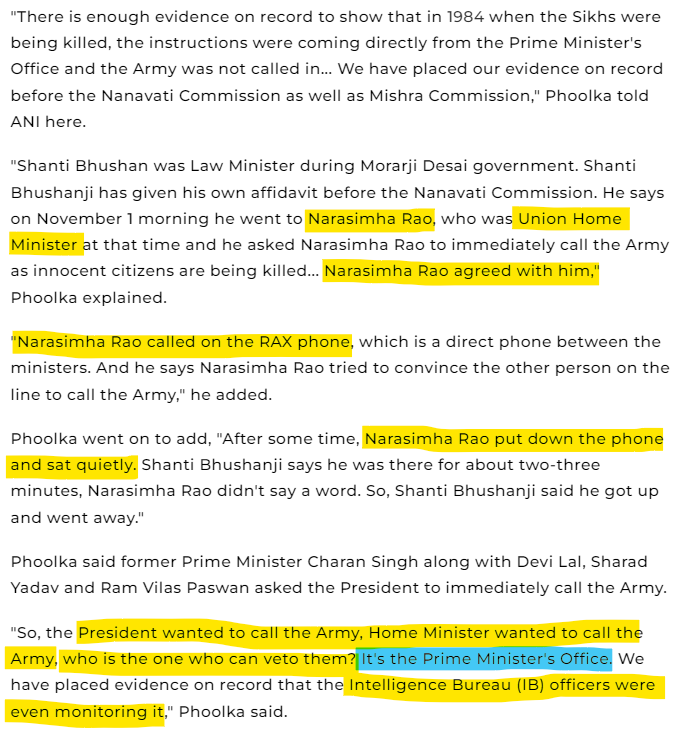
That Rajiv Gandhi had become incommunicado when the President, Mr. Giani Zail Singh was asking for the Army, is a fact that even the President's Press Secretary, Mr. Tarlochan Singh, has confirmed.
Mr. Singh shared that the attacks were "orchestrated and sponsored and claimed that the then PM Rajiv Gandhi did not even take calls from the President when he tried to get in touch with him."
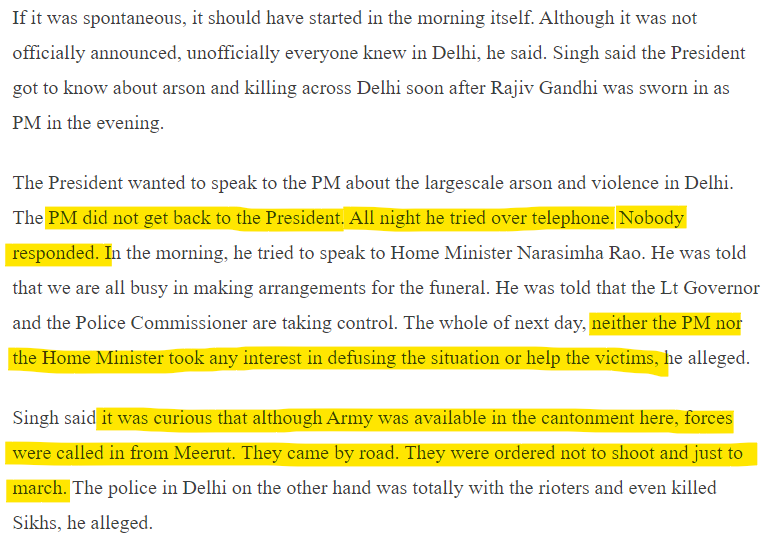
The whole situation with the Army was orchestrated by the government so that Army would not intervene in time.
General AS Vaidya's statements to the Ranganath Mishra Commission were contradicted by Subhash Tandon. The Commission found that Tandon's take was facetious and incorrect.
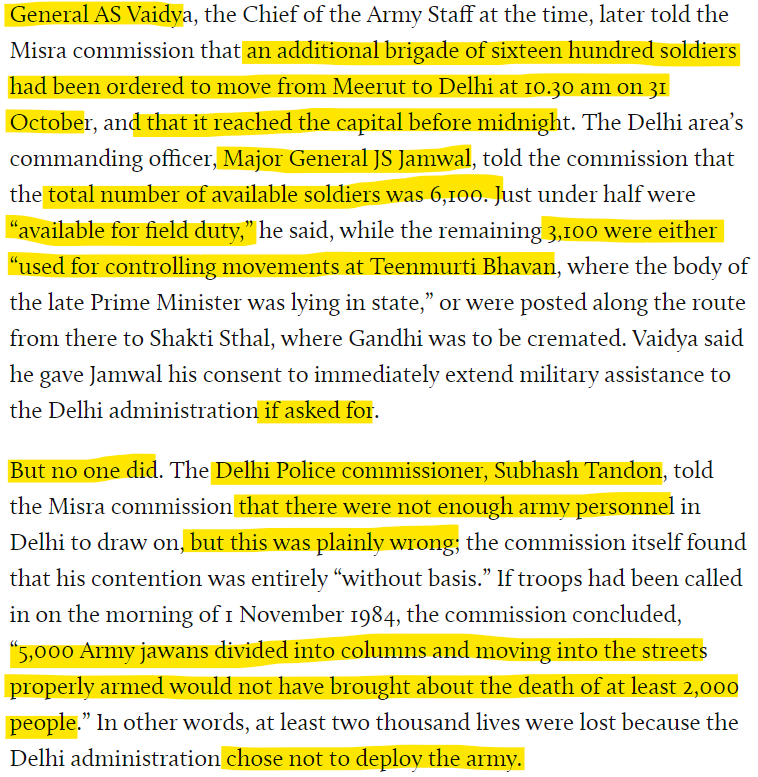
As President Zail Singh made his way back from Yemen to be in India, the attacks had started. He reached the hospital at 5.20 pm, and on the way, his Press Secretary's car was attacked. While the President was leaving AIIMS, his own car was mobbed. Mr. Tarlochan Singh shares what happened that tense and scary evening.
Please see around 3.00-3.27 mark in the above video, where Mr. Tarlochan Singh says that before Rajiv Gandhi arrived back in Delhi from Calcutta, a meeting took place where they were surprised that despite such a huge event, nothing was happening in terms of protests or anger. They decided that "Khoon ka Badla Khoon" will be the main slogan along with others. The message was sent to the supporters and that is how the mob that had gathered at AIIMS suddenly started these slogans.
The night of October 31st was the night of shameless evil.
Congress leaders met with the local leaders to action the next steps - execute the massacre of Sikhs by distributing money and weapons.
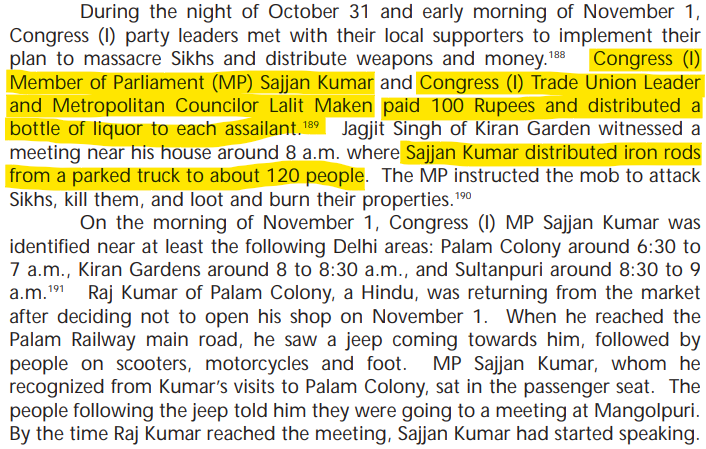
The stage was set. Messages given and troops readied.
The Congress Party had readied the lists to target the Sikhs. In a typical Nazi-style targeting, the homes and businesses of Sikhs were marked with an "S"
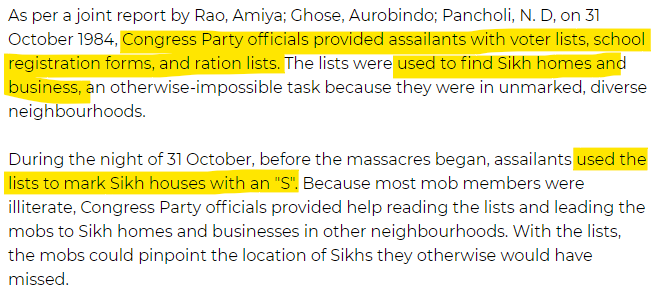
Armed with the lists and the arms, the mobs would go looking for Sikhs the next morning.
Block 32, Trilokpuri - the Ground Zero
Trilokpuri was the area where one of the worst massacres took place. Block 32, Trilokpuri was the Ground Zero of the Anti-Sikh massacres.
The police were not just quiet witnesses, but their role was deviously evil. They set the Sikhs up for being massacred by the Congress goons that night of November 1st.
“On the evening of November 1, 1984, police in Trilokpuri disarmed all the Sikhs and told us to go inside our homes. They said they would protect us. That night, there was no electricity, it was pitch dark. Most people were preparing to retire for the day, some of us had gone to a naala nearby to relieve ourselves, when a mob came charging. That saved me and a few others. All the men in the homes were killed. The attackers were drunk, they raped our women and burnt our children. My brothers are gone,” says Singh, breaks down. Maliakan, sitting cross-legged on the bed with his old friend, consoles him. The two men continue holding hands. (Source: Indian Express "The bodies were here, everywhere..")
What the bloodthirsty mobs unleashed on the hapless Sikh families was the terror of the worst kind. No human being can stoop so low or handle such horrendous treatment.
Here are some excerpts of what the goons inspired by the Congress leaders did to the Sikhs in Trilokpuri.
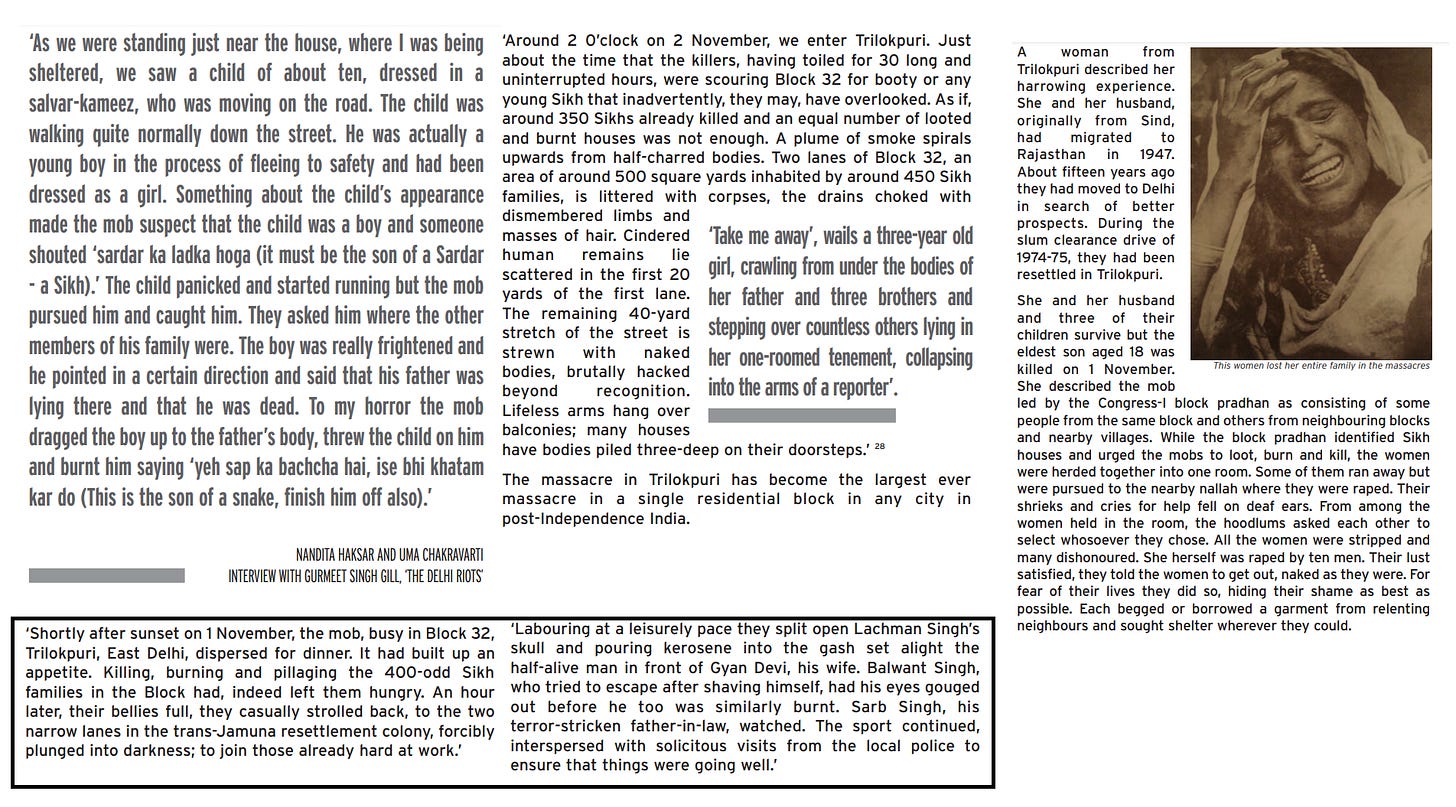
When the Delhi Commissioner - Subhash Tandon - was forced to go to Trilok Puri, he chickened out and ran away. The Police Commissioner of Delhi!
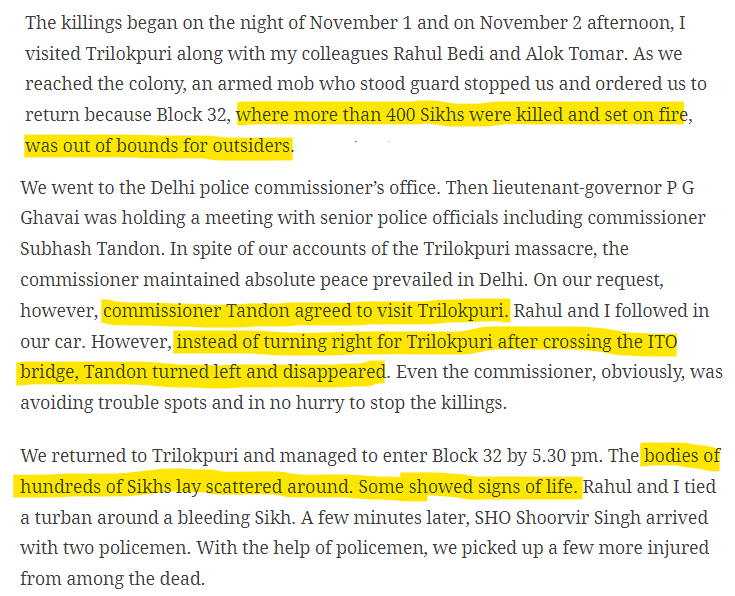
Here is a map of the areas that were attacked by the mobs.
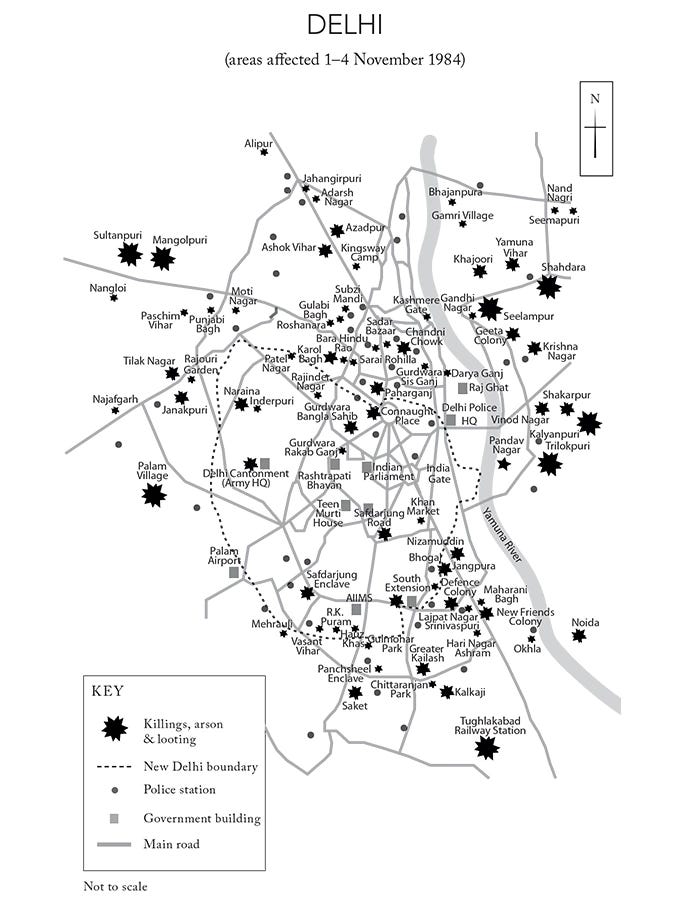
Just like Jinnah's mobs during the partition had used petrol (please read Newsletter #333: The Real Story of India's Partition), the Congress-led mobs were using petrol, tires, and another devastating weapon - The White Powder.
This white powder was in all probability white phosphorous. This is not stocked in any household or local stores. (Source: "How Senior Congress Leaders Sanctioned The Organised Violence Against Sikhs In 1984", Caravan by Hartosh Singh Bal) but is an industrial-grade chemical.
White Phosphorous is used to manufacture chemicals used in fertilizers, food additives, and cleaning compounds.
What is Willie Pete or White Phosphorous?
White Phosphorous causes the skin to melt away and can break down the victim's jaw bone. The burns caused by it are deep (to the bone) and very painful. It burns at a temperature of up to 2,760 degrees Celsius (5,000 degrees Fahrenheit). (Source) Use of White Phosphorous is a serious concern as it is tightly regulated under international law. Or so it is said. But it is not banned.
Because of its incendiary effects, the use of phosphorus in war is supposed to be tightly regulated under international law — but it is not banned. Phosphorus is not classed as a chemical weapon under the Chemical Weapons Convention. (Source)
The use of White Phosphorous on civilians is extremely dangerous. It can not just burn through flesh and bones but even metal.
"Incendiary weapons cause devastating burns, and in far worse ways than any of the standard scald or fire burns," Dr. Rola Hallam, a physician who treated incendiary weapons victims in Syria, said in a report by Human Rights Watch. "They can burn through everything. If they can burn through metal, what hope does human flesh have?" (Source)
That is what the Congress leaders and supporters are said to have used to burn Sikhs.
The question is who could have procured such large amounts of White Phosphorus, a chemical used to manufacture Fertilizers and distributed to the raging mobs attacking the Sikhs? Which Fertilizer and Chemical industry did the mobs have access to and how?
📧
To get such detailed analysis based on deep research, please subscribe to our newsletter right away. Be a Member.
Gurudwara Rakab Ganj - attack led by the Congress leaders
One such incident occurred at Gurudwara Rakab Ganj. As per the testimony of Monish Sanjay Suri, staff reporter of Indian Express, and added to by the eyewitness Mukhtiar Singh, given to the Nanavati Commission, on November 1st, 2 Head Constables and 14 Home Guard Constables were posted at the Gurudwara.
Mukhtiar Singh and Ajit Singh resided within the Gurudwara. Mobs were outside the Gurudwara and the sewadars who wanted to go home could not get out.
At 9.02, a message was flashed in the police Control room that Sikh men were inside the Gurudwara with swords and bhaalas. When the SHO of the area who was at Teen Murti went to inquire and found there was no truth in that. He left.
At 11.00, a large mob attacked the Gurudwara - Gurudwara Rakab Ganj. They pelted stones at the people inside and the Gurudwara. Police constables near the Gurudwara did nothing.
When the mob tried to enter between 11.30 and 12.00 the sewadars were able to push them out. An elderly man with folded hands tried to go to the mob to reason.
He was dragged out of the Gurudwara premises and beaten. As he fell, someone from the mob put the White Phosphorus powder on him and set him on fire.
His son ran to his help from inside the Gurudwara. He met with the same fate as he was set to fire as well!
Badly burned, the two were still alive. When the police were begged to take them to the hospital, they refused any help. The father died after a few minutes, but the young man continued to suffer for 3-4 hours before dying.
The attack on Gurudwara Rakab Ganj continued. The mob entered the Gurudwara. At that time, one person who had a licensed gun tried to frighten the mob by firing from it.
Now the mob became bigger. And it was accompanied by two of the biggest Congress leaders, as per the eyewitness accounts.
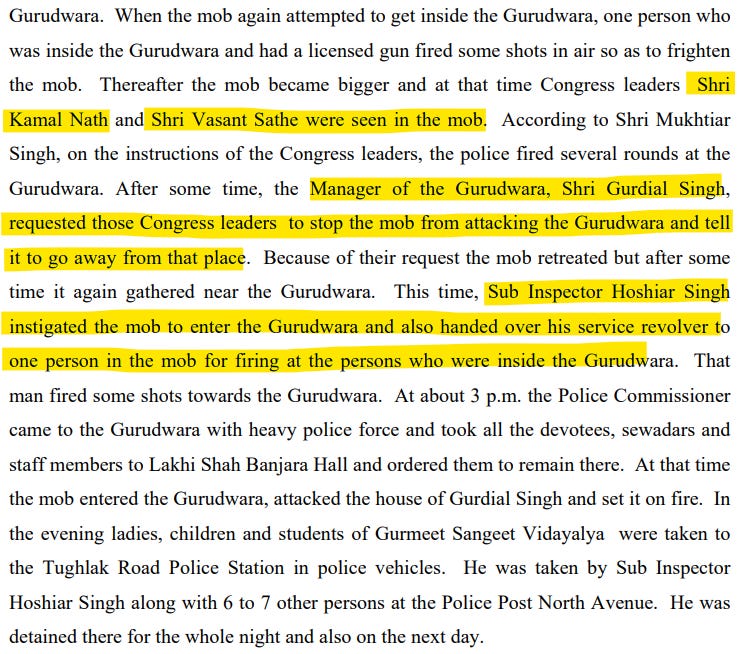
Vasant Sathe was a senior Union Minister in the Congress government. He was in charge of the Ministry of Information and Broadcasting in 1980, Chemicals and Fertilizers in 1982, Steel, Mines and Coal in 1985, Energy in 1986, and Communications in 1988-89.
Vasant Sathe was the Minister of Chemicals and Fertilizers in 1984! (Source)
Injustices by the Commissions
Many Commissions of inquiry led by major Supreme Court Justices were formed and they basically towed the government line.
While Justice Ranganath Mishra gave a clean chit to Congress as he rejected affidavits by the victims and witnesses, Justice Nanavati took the word of the accused Congress leaders above those of the victims.
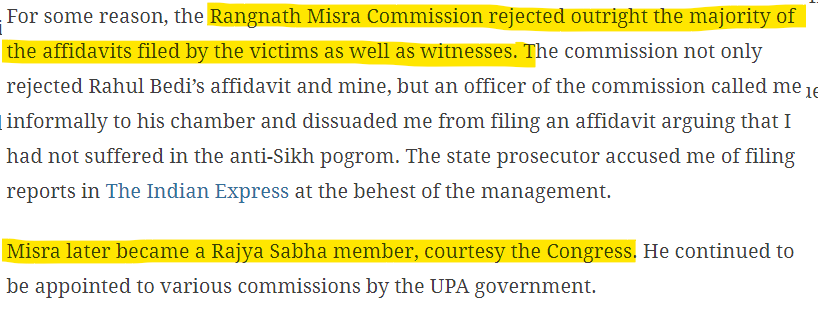
Many Commissions were set up to probe but these commissions found reasons to push back on the testimonies of hundreds of victims for some reason or the other.
Commission Year Argument Justice Ranganath Misra Commission 1985 While calling police “indifferent or negligent”, the Commission said that the Congress party or its leaders had not participated in the riots, even though “some persons belonging to the Congress party on their own did indulge or participate in the riots for considerations entirely their own”. Kapoor-Mittal Committee 1987 The Home Ministry found Justice Kapoor’s report to be a sociological analysis dealing in generalities, and decided to accept Mittal’s report and take action against police officials on the basis of its findings. Seventy-two police officers were indicted for lapses in controlling the riots. R K Ahuja Committee 1987 Objective - to find exact number of deaths in Delhi. the Committee determined that 2,733 deaths had occurred in the Capital Justice J D Jain and retired IPS officer D K Aggarwal Committee 1990 Looked into affidavits before Mishra Commission and fresh ones plus 403 FIRs. The Committee found that no separate FIRs were recorded for individual incidents, no case-by-case investigation was carried out, and no incident-wise evidence was produced during the trial, leading to acquittals in most cases. Justice Nanavati Commission 2000 Recommended payments to victims and also give their relatives jobs. The Commission recommended re-opening only 4 out of 241 cases closed by the police. In most cases, Justice Nanavati did not find "evidence to be sufficient" because the accused refused their crimes.
Reading the reports of various Commissions is a painful exercise. One can easily see how these investigations were a complete sham from get-go.
Cementing the lie, the Congress Way
In 1999, the then former Finance Minister and later India's Prime Minister, Dr. Manmohan Singh made a statement about the 1984 riots. And, he lied through his teeth.
Instead of acknowledging the role of Congress, Dr. Manmohan - as has been the wont of all Congress leaders - blamed the 1984 anti-Sikh massacres on the RSS!
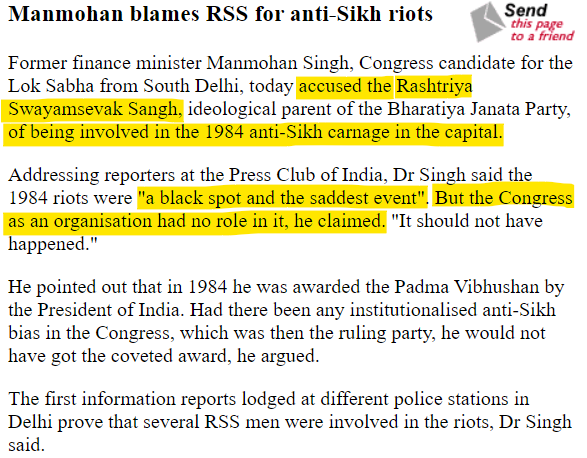
Interestingly, Dr. Manmohan Singh apologized in Parliament in June 2013 - albeit in a way that was meant to exonerate Congress despite his apology.
The obvious question to everyone was - if Congress was really not involved, then why was Dr. Singh seeking an apology?
The Shoe Hurled
When Dr. Manmohan Singh assumed office as the Prime Minister in his first term on May 22nd, 2004, there was one minister in his cabinet who shouldn't have been.
Jagdish Tytler. Minister of Overseas Indian Affairs.
After the Nanavati Commission report was submitted to the Parliament on August 8th, 2005 (Source), things heated up for him and Dr. Singh.
On August 10th, 2005 Jagdish Tytler gave in his resignation from the ministry to Sonia Gandhi (not Dr. Singh) ostensibly to "save the government from embarrassment."
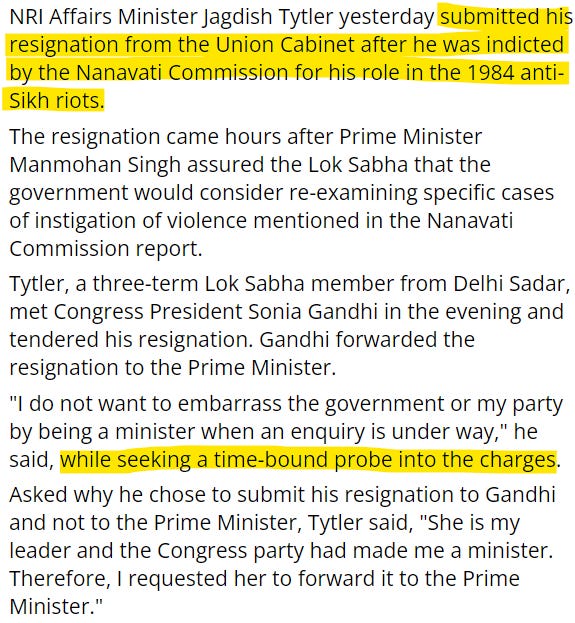
Later CBI was tasked to 'investigate' Tytler's role.
On April 7, 2009, a week after the CBI gave a clean chit to Jagdish Tytler, and just a few days before the Lok Sabha elections - the man who was said to have been responsible for leading the mobs in 1984 targeting Sikhs, a journalist named Jarnail Singh threw a shoe at P. Chidambaram for having agreed with the CBI.
Actually, for orchestrating Tytler's acquittal. Since Chidambaram was the then Home Minister.
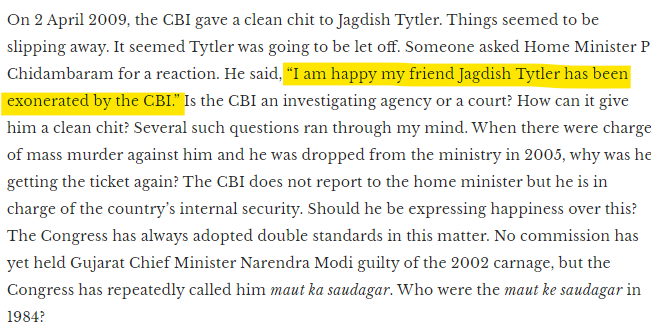
When Jarnail Singh probed Chidambaram further, he felt that the minister was trying to bury the case. As he persisted on why Chidambaram felt good about the clean chit, the minister tried to tip-toe around the case. Frustrated, Singh threw one of his shoes at Chidambaram.
This shoe-hurling incident opened a pandora's box and due to increased focus on them, Congress did not give the ticket in the 2009 Lok Sabha elections to Jagdish Tytler and Sajjan Kumar.
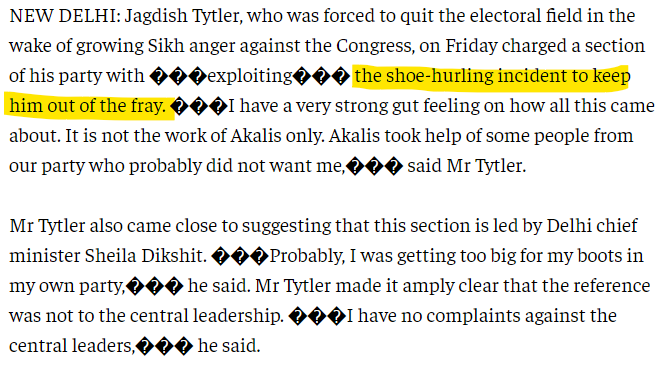
CBI was forced to file a fresh case against Sajjan Kumar on April 8, 2009 due to the intense focus and protests triggered by the shoe-hurling. In 2018, Congress Leader Sajjan Kumar was finally convicted.

On December 17, 2018 (Monday), the Delhi High Court sentenced Sajjan Kumar to life imprisonment.
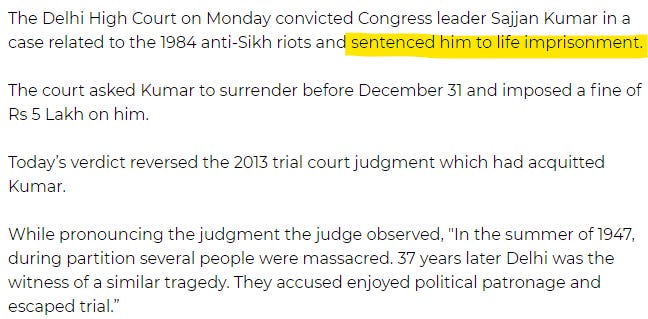
In 2020, Sajjan Kumar approached the Supreme Court for bail but the Justices refused.
"Sorry. We are not inclined. Dismissed," said a bench headed by Chief Justice of India (CJI) SA Bobde while hearing Sajjan Kumar's plea seeking interim bail on health grounds. The Supreme Court bench also included Justice AS Bopanna and V Ramasubramanian. CJI SA Bobde also declined Sajjan Kumar's plea for hospitalisation, saying he didn't need to be sent to a hospital as per his medical report at the moment. (Source: India Today)
He remains in jail as of today.
Tytler and Dharam Das Shatri are still alive and free from amongst the gang of Congress leaders who actively executed the Sikh massacres of 1984.
Video corner - Sri Lanka explodes
While Ukraine is witnessing a deadly war, and Pakistan's government is imploding, Sri Lanka is exploding. In Sri Lanka, life has become almost impossible!
Drowning in debt, and sky-rocketing inflation, the Sri Lankans are facing shortages and lack of money. Hunger, disease, and death are becoming the norm.
President Gotabaya Rajapaksa is under attack. Check out what is going on in the island country.
If you like our content and value the work that we are doing, please do consider contributing to our expenses. CHOOSE THE USD EQUIVALENT AMOUNT you are comfortable with.
If you like this post - please share it with someone who will appreciate the information shared in this edition.
Today’s ONLINE PAPER: Check out today’s “The Drishtikone Daily” edition. - THE DRISHTIKONE DAILY




